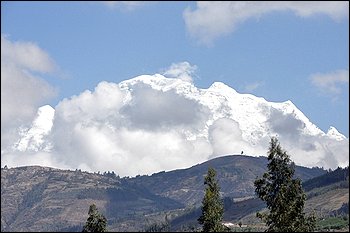
This a guest post by the Climate BS Awards committee.
Welcome to the 2010 Climate B.S.* of the Year Award. 2010 saw widespread and growing evidence of rapidly warming global climate and strengthening scientific understanding of how humans are contributing to climate change. Yet on the policy front, little happened to stem the growing emissions of greenhouse gases or to help societies prepare for increasingly severe negative climate impacts, including now unavoidable changes in temperature, rainfall patterns, sea-level rise, snowpack, glacial extent, Arctic sea ice, and more. These physical impacts will lead to sharply increased disease, military and economic instabilities, food and water shortages, and extreme weather events, among other things. Without appropriate risk management action, the United States will be hit hard. There is no safe haven. Yet confusion and uncertainty about climate change remain high in the minds of too many members of the public and Congress.
Why? In large part because of a concerted, coordinated, aggressive campaign by a small group of well-funded climate change deniers and contrarians focused on intentionally misleading the public and policymakers with bad science about climate change. Much of this effort is based on intentional falsehoods, misrepresentations, inflated uncertainties, and pure and utter B.S. about climate science. These efforts have been successful in sowing confusion and delaying action – just as the same tactics were successful in delaying efforts to tackle tobacco’s health risks.
To counter this campaign of disinformation, we are issuing the first in what may become a series of awards for the most egregious Climate B.S.* of the Year. In preparing the list of nominees, suggestions were received from around the world and a panel of reviewers – all scientists or climate communicators – waded through them. We present here the top five nominees and the winner of the 2010 Climate B.S.* of the Year Award.
Fifth Place. Climate B.S. and misrepresentations presented by Fox “News.”
There are many examples of bad science, misrepresentations, omissions of facts, and distortions of climate reality coming from Fox “News” (far too many to list here, but we note that Joe Romm just gave Fox his 2010 Citizen Kane Award for “non-excellence in journalism” for their misrepresentations of climate science). It seems that Fox has now made it their policy to deny the reality of climate change and has told its reporters to misreport or cast doubt on the science. This policy of disinformation was implemented by Fox News executive Bill Sammon, who ordered staff to cast doubt on climate data in a memo revealed this month. Fox’s political commentators have long used this tactic in their one-sided and biased discussions on climate change but Sammon’s memo seems to direct News staff to slant reporting in direct contradiction to what the scientific facts and scientists actually say.
Fourth Place. Misleading or false testimony to Congress and policymakers about climate change.
While Congress held more hearings in 2010 on climate change than in other recent years, these hearings elicited some astounding testimonies submitted by climate deniers and skeptics filled with false and misleading statements about climate science and total B.S. Examples?
Long-time climate change skeptic Patrick Michaels testified before the House Science and Technology Committee and misrepresented the scientific understanding of the human role in climate change and the well-understood effects of fundamental climatic factors, such as the effects of visible air pollution. Including these effects (as climate scientists have done for many years) would have completely changed his results. Michaels has misrepresented mainstream climate science for decades, as has been noted here, here, and elsewhere, yet he remains a darling of the skeptics in Congress who like his message.
A newer darling of Congressional climate change deniers is Christopher Monckton, who claims to be a member of the British House of Lords (a claim rejected by the House of Lords). Monckton testified before a Senate committee in May and presented such outlandish B.S. about climate that experts (such as John Mashey, Tim Lambert, John Abraham, and Barry Bickmore, to name a few) spent uncounted hours and pages and pages refuting just a subset of his errors.
Third Place. The false claim that a single weather event, such as a huge snowstorm in Washington, D.C., proves there is no global warming.
In February 2010 a big winter storm dumped record piles of snow on the mid-Atlantic U.S., including Washington, Baltimore, and Philadelphia, prompting climate change deniers to use bad weather to try to discredit the reality of global warming. Limbaugh said, “It’s one more nail in the coffin for the global warming thing.” Oklahoma Senator James Inhofe got attention with an igloo on the national mall and labeled it “Al Gore’s new home” (combining bad science with a personal attack). Senator Jim DeMint said, “It’s going to keep snowing in DC until Al Gore cries ‘uncle.’”
Record snowfall is not an indicator of a lack of global warming, as has been pointed out in the scientific literature and many, many rounds of Congressional testimony. It merely means that there was a storm and temperatures were close to or below freezing. Indeed global warming can contribute to greater snowfalls by providing extra moisture. Many scientists testifying before the Senate and House of Representatives have explained the difference between a steadily warming planet and occasional extreme cold events in particular spots. But we can expect to see more examples of this kind of B.S. when it gets cold and snowy somewhere, sometime, this winter.
Second Place. The claim that the “Climategate” emails meant that global warming was a hoax, or was criminal, as Senator Inhofe tried to argue. In fact, it was none of these things (though the British police are still investigating the illegal hacking of a British university’s computer system and the theft of the emails).
Global warming deniers used out-of-context texts from the stolen emails to claim that global warming was a hoax or that scientists had manipulated data or were hiding evidence that climate change wasn’t happening. These claims are all B.S. A series of independent scientific and academic investigations in the U.S. and the U.K. unanimously concluded that nothing in the stolen emails made any difference to the remarkable strength of climate science (see, for example, the Penn State vindication, the independent Muir Russell and Lord Oxburgh reviews, a British Parliamentary Panel review, and other assessments). Unfortunately, the media gave far more attention to the accusations than to the resounding vindications, and climate deniers continue to spread B.S. about this case.
The bottom line of “Climategate?” As a letter in Science magazine signed by 255 members of the US National Academy of Sciences said in May 2010: “there is nothing remotely identified in the recent events that changes the fundamental conclusions about climate change.”
WINNER OF THE 2010 CLIMATE B.S.* OF THE YEAR AWARD
First Place goes to the following set of B.S.: “There has been no warming since 1998” [or 2000, or…], “the earth is cooling,” “global warming is natural,” and “humans are too insignificant to affect the climate.” Such statements are all nonsense and important for the general public to understand properly.
The reality is that the Earth’s climate is changing significantly, changing fast, and changing due to human factors. The reality of climatic change can no longer be disputed on scientific grounds – the US National Academy of Sciences calls the human-induced warming of the Earth a “settled fact.” The evidence for a “warming” planet includes not just rising temperatures, but also rising sea levels, melting Arctic sea ice, disappearing glaciers, increasing intense rainfalls, and many other changes that matter to society and the environment. The recent and ongoing warming of the Earth is unprecedented in magnitude, speed, and cause.
This winning set of B.S. appears almost daily in the conservative blogosphere, like here and here and here, consistently in the statements of climate change deniers, and far too often in real media outlets. Actual science and observations from around globe have long shown the opposite (for example, here and here are nice rebuttals with real science). The planet continues to warm rapidly largely due to human activities, and average global temperatures continue to rise. The most recent decade has been the warmest decade on record and 2010 will likely go down as either the warmest or second warmest year in recorded history.
Associated B.S. argues that the famous “hockey stick” graph has been disproved. This graph shows the extraordinarily rapid warming of the twentieth century compared to the previous 1000 years. The graph and analysis have been upheld by subsequent researchers and numerous scientific assessments, including one from the US National Academy of Sciences.
To the winners: congratulations, it is long past time your B.S. is recognised for what it is – bad science.
And to the public and the media: be forewarned: all of these and similar bad arguments will certainly be repeated in 2011. It is long past time that this bad science is identified, challenged, and shown to be the B.S. that it is.
The 2010 Climate Bad Science (B.S.) Detection and Correction Team
Peter Gleick, Kevin Trenberth, Tenney Naumer, Michael Ashley, Lou Grinzo, Gareth Renowden, Paul Douglas, Jan W. Dash, Ove Hoegh-Guldberg, Brian Angliss, Joe Romm, Peter Sinclair, Michael Tobis, Gavin Schmidt, John Cook, plus several anonymous nominators, reviewers, and voters.
[* “B.S.” means “Bad Science” — doesn’t it?]
Like this:
Like Loading...




